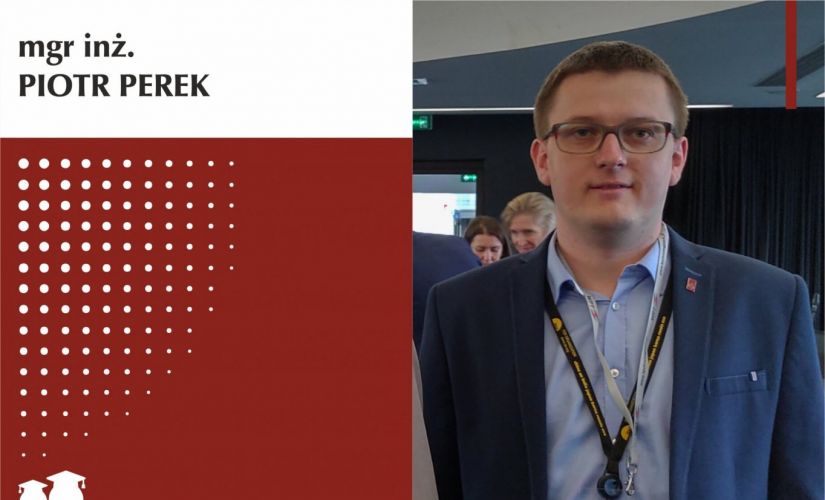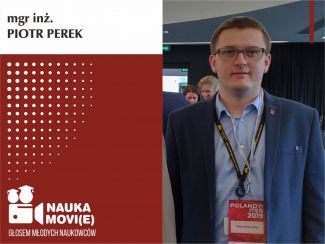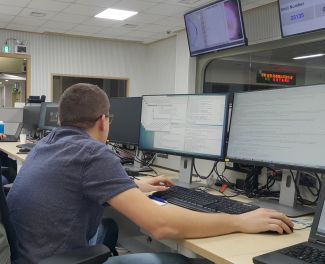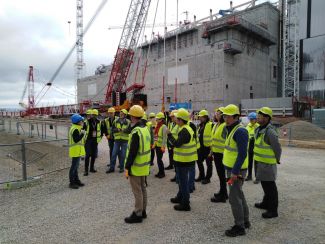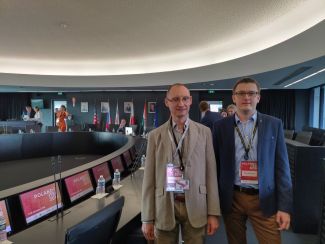Budowa sztucznego słońca – to zadanie, w jakie zaangażowany jest zespół naukowców z Katedry Mikroelektroniki i Technik Informatycznych PŁ. W tym multidyscyplinarnym i międzynarodowym projekcie ITER uczestniczy mgr inż. Piotr Perek.
Zajmuje się tam szeroko pojętym rozwojem oprogramowania na potrzeby systemów diagnostycznych. To nie lada wyzwanie, zważywszy na zakres projektu ITER – zaangażowanie 35 krajów, wartość szacowana na 18 mld euro. Celem projektu jest osiągniecie 10-krotnego zysku energetycznego, a tym samym wykazanie możliwości wykorzystania kontrolowanej fuzji termojądrowej do produkcji energii na masową skalę.
Mgr inż. Piotr Perek jest również m.in. autorem rozwiązania Asystent rejestracji obrazu stereoskopowego, za który otrzymał złoty medal na XXII International Salon of Research, Innovation and Technological Transfer INVENTICA 2018 w Rumunii oraz Seoul International Invention Fair SIIF 2018 w Korei Południowej.
Jak wyglądała Pana droga do pracy badawczej?
Na IV roku studiów magisterskich dołączyłem do zespołu z Katedry Mikroelektroniki i Technik Informatycznych, który współpracuje z ośrodkiem DESY (Deutsches Elektronen-Synchrotron) w Hamburgu. Naszym zadaniem był rozwój systemów sterowania dla akceleratorów FLASH (Free Electron Laser in Hamburg) oraz EXFEL (European X-Ray Free Electron Laser). Tego typu lasery są używane do badań nanoskali, a wykorzystywane nie tylko przez fizyków. Urządzenia służą m.in. ekspertom w medycynie, farmacji, badaniach materiałowych.
W ośrodku DESY odbyłem również wakacyjne praktyki studenckie. To doświadczenie pokazało mi, że wyśrubowane wymagania, które napotykają wykonawcy systemów elektroniczno-informatycznych, mogą być ciekawymi wyzwaniami, również na polu badań naukowych.
Którą dyscypliną naukową się Pan zajmuje?
Moje prace związane są z projektowaniem oraz rozwojem systemów elektroniczno-informatycznych wykorzystywanych do sterowania i diagnostyki eksperymentów fizyki wielkiej skali. Jak już wspomniałem moje początki związane były z systemami sterowania dla akceleratorów cząstek elementarnych. Obecnie moje prace skupiają się bardziej na systemach diagnostycznych dla urządzeń fuzyjnych (np. tokamaków ITER i KSTAR oraz stellaratora W7-X). Każde z nich umożliwia kolejny krok w kierunku wykorzystania fuzji termojądrowej do budowy elektrowni. Są to działania na pograniczu elektroniki i informatyki, ponieważ nasz zespół zajmuje się dostarczaniem kompletnych systemów, począwszy od projektu urządzeń elektronicznych, poprzez oprogramowanie układowe, a na wysokopoziomowym oprogramowaniu sterującym kończąc.
Budowa sztucznego słońca, jak określa się projekt ITER, jest cywilizacyjnym wyzwaniem. Co należy do Pana zadań?
Zajmuję się szeroko pojętym rozwojem oprogramowania na potrzeby systemów diagnostycznych. Jestem odpowiedzialny za rozwój zarówno oprogramowania na poziomie układowym (np. dla mikrokontrolerów monitorujących stan pojedynczych modułów pomiarowych), jak i złożonych aplikacji do akwizycji i przetwarzania danych.
Jednym z przykładów mogą być systemy obrazowe na potrzeby diagnostyki plazmy wykorzystujące superszybkie kamery pracujące z przepustowościami rzędu gigabitów na sekundę (Gb/s). Do moich zadań należy opracowywanie sterowników urządzeń z wykorzystaniem wydajnych mechanizmów do transmisji dużych strumieni danych; bibliotek niezbędnych do sterowania naszymi urządzeniami oraz wydajnych aplikacji i systemów informatycznych do akwizycji i przetwarzania obrazu m.in. z wykorzystaniem procesorów graficznych.
Zajmuję się również zagadnieniami akwizycji i przetwarzania danych w czasie rzeczywistym. Jest to szczególnie istotne w przypadku systemów diagnostycznych, które muszą dostarczać pomiary dla systemu kontroli plazmy. Obecnie pracuję nad oprogramowaniem dla prototypowego systemu do pomiaru temperatury i gęstości plazmy bazującego na zjawisku rozpraszania Thomsona. Oprogramowanie opracowywane przeze mnie we współpracy z ośrodkami ITER i KSTAR ma na celu akwizycję danych z przetworników analogowo-cyfrowych o częstotliwości próbkowania 5GS/s, a następnie ich przetworzenie i przesłanie wyników w czasie kilkunastu milisekund.
Jest Pan absolwentem elektroniki i telekomunikacji - jak wiedza ze studiów przydaje się w dzisiejszej pracy?
Z perspektywy czasu mogę powiedzieć, że był to bardzo dobry wybór, ponieważ studia te dały mi gruntowne podstawy zarówno w zakresie elektroniki, projektowania i programowania systemów wbudowanych, jak i informatyki. Ze względu na to, że pracujemy z zaawansowanymi systemami sterowania i akwizycji danych, często napisanie oprogramowania wiąże się z koniecznością zapoznania z zasadami działania sprzętu elektronicznego, z którym ma się ono komunikować. Również projektowanie systemów wymaga wiedzy zarówno z zakresu elektroniki, jak i informatyki. Mimo tego, że studia są jedynie wstępem do zagadnień i problemów, z którymi mierzymy się w zawodowym życiu, sądzę, że wszechstronna wiedza, którą zdobyłem, pomaga w rozwiązywaniu interdyscyplinarnych problemów.
Dlaczego warto być naukowcem?
Praca naukowa okazała się dla mnie ciągłym wyzwaniem. Cieszy również fakt, że uczestniczę w eksperymentach fizyki wielkiej skali, które przesuwają do przodu granice poznania i możliwości ludzkości. Mimo tego, że niejednokrotnie wybrane sposoby rozwiązania problemu okazują się ślepą uliczką, warto próbować, żeby poczuć, że udało się osiągnąć rozwiązanie mogące stać się kolejną cegiełką do budowy czegoś wielkiego. Praca naukowa dała mi też możliwość odwiedzenia wielu miejsc i ośrodków badawczych na całym świecie oraz poznania ciekawych ludzi i kultur.
Więcej o zaangażowaniu naukowców Politechniki Łódzkiej w projekcie ITER na blogu.

